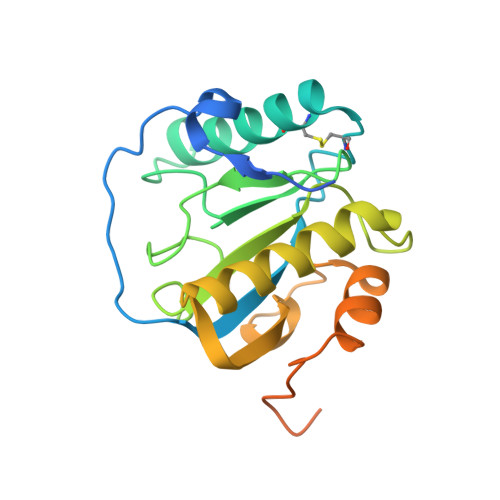PGRP-LB: An Inside View into the Mechanism of the Amidase Reaction.
Orlans, J., Vincent-Monegat, C., Rahioui, I., Sivignon, C., Butryn, A., Soulere, L., Zaidman-Remy, A., Orville, A.M., Heddi, A., Aller, P., Da Silva, P.(2021) Int J Mol Sci 22
- PubMed: 34066955
- DOI: https://doi.org/10.3390/ijms22094957
- Primary Citation of Related Structures:
7NSX, 7NSY, 7NSZ, 7NT0 - PubMed Abstract:
Peptidoglycan recognition proteins (PGRPs) are ubiquitous among animals and play pivotal functions in insect immunity. Non-catalytic PGRPs are involved in the activation of immune pathways by binding to the peptidoglycan (PGN), whereas amidase PGRPs are capable of cleaving the PGN into non-immunogenic compounds. Drosophila PGRP-LB belongs to the amidase PGRPs and downregulates the immune deficiency (IMD) pathway by cleaving meso -2,6-diaminopimelic ( meso -DAP or DAP)-type PGN. While the recognition process is well analyzed for the non-catalytic PGRPs, little is known about the enzymatic mechanism for the amidase PGRPs, despite their essential function in immune homeostasis. Here, we analyzed the specific activity of different isoforms of Drosophila PGRP-LB towards various PGN substrates to understand their specificity and role in Drosophila immunity. We show that these isoforms have similar activity towards the different compounds. To analyze the mechanism of the amidase activity, we performed site directed mutagenesis and solved the X-ray structures of wild-type Drosophila PGRP-LB and its mutants, with one of these structures presenting a protein complexed with the tracheal cytotoxin (TCT), a muropeptide derived from the PGN. Only the Y78F mutation abolished the PGN cleavage while other mutations reduced the activity solely. Together, our findings suggest the dynamic role of the residue Y78 in the amidase mechanism by nucleophilic attack through a water molecule to the carbonyl group of the amide function destabilized by Zn 2+ .
- Univ Lyon, INSA Lyon, INRAE, BF2I, UMR 203, 69621 Villeurbanne, France.
Organizational Affiliation:

















